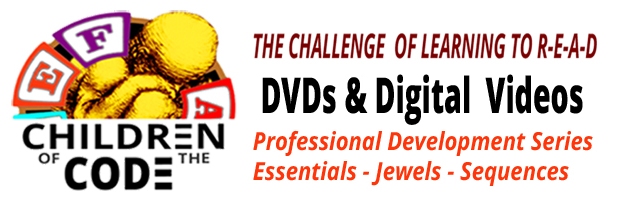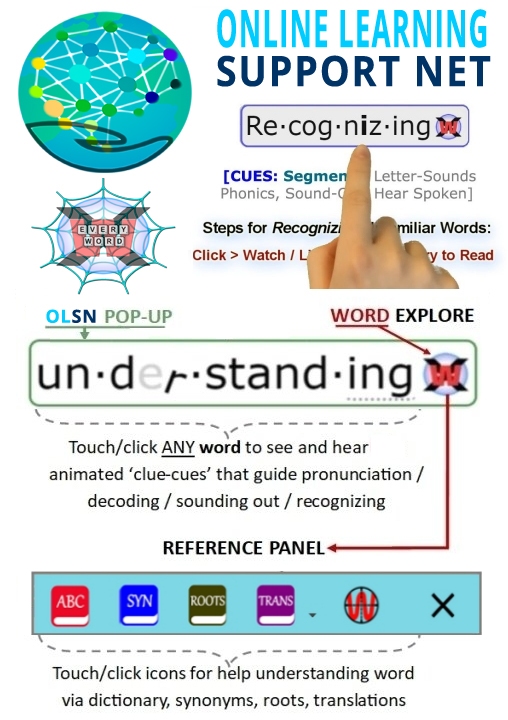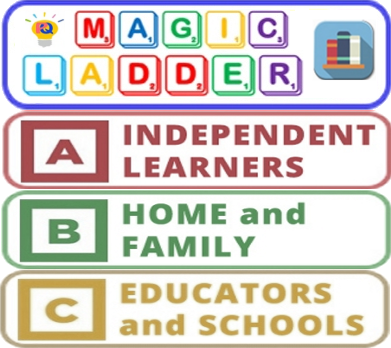Learning Disabilities
Note: Remember to click on any word on this page to experience the next evolutionary step in technology supported reading.
Learning Disabilities
Information processing really is an issue that cuts across so many different disabilities. The term learning disabilities is itself an umbrella term that encompasses a wide range of disorders and problems, the biggest one being dyslexia or reading disability. And even within reading disability, there could be problems with decoding, there could be problems with comprehension, there could be problems with expression, any number of things. So, it’s the processing of information that is really critical. Rock bottom: How does the brain either work or not work in dealing with that information?
James Wendorf, Executive Director, National Center for Learning Disabilities. Source: COTC Interview – http://www.childrenofthecode.org/interviews/wendorf.htm#LearningDisabilities
Five to Six Percent of Kids Have Dyslexia or Learning Disabilities
When we look at the kids who are having a tough time learning to read and we went through the statistics, thirty-eight percent nationally, disaggregate that, seventy percent kids from poverty and so forth hit the wall. Ninety-five percent of those kids are instructional casualties. About five to six percent of those kids have what we call dyslexia or learning disabilities in reading.
G. Reid Lyon, Past- Chief of the Child Development and Behavior Branch of the National Institute of Child Health & Human Development, National Institutes of Health, Current senior vice president for research and evaluation with Best Associates. Source: COTC Interview – http://www.childrenofthecode.org/interviews/lyon.htm#Instructionalcasualties
Seventy to Eighty Percent of Students with Learning Disabilities Have Main Problem with Reading
Reading is the gateway skill. It leads to all sorts of success, both academically and in life. It is the skill that under girds most of the curriculum, and if children aren’t learning that skill by the end of third grade, they are in desperate trouble. For kids with learning disabilities it’s a doulbe whammy. You know, seventy to eighty percent of students with learning disabilities have their main problem in the area of reading, with reading based learning disabilities.
James Wendorf, Executive Director, National Center for Learning Disabilities. Source: COTC Interview – http://www.childrenofthecode.org/interviews/wendorf.htm#ReadingistheGatewaySkill
Nation's Greatest Learning Disability
David Boulton: And inside of the learning disabilities or learning differences you encountered reading was the big one.
Dr. Edward Kame’enui: Oh yeah, absolutely. Hands down, hands down. I have great colleagues here who work with serious behavior problems. I could have done that, but I realized that, to me, that was not the problem. The problem was in the learning, in the acquisition of information, retention, and so on.
David Boulton: Connected to what you’re saying, it seems to me that the nation’s biggest learning disability is engendered by the process of learning to read.
Dr. Edward Kame’enui: Oh, absolutely.
David Boulton: Right?
Dr. Edward Kame’enui: Yes, yes, absolutely. It’s the most public — I mean…
David Boulton: The most widespread learning-disabling thing that happens to human beings is the process of learning to read.
Dr. Edward Kame’enui: Absolutely. And the most public. For example, you can hide from the math stuff. You can get away with the math because you have enough other systems that can help you on that. But the reading one is tough. It’s hard to hide on that one. That’s a good point.
Edward Kame’enui, Past-Commissioner for Special Education Research where he lead the National Center for Special Education Research
under the Institute of Education Sciences. Source: COTC Interview – http://www.childrenofthecode.org/interviews/kameenui.htm#NationGreatestDisability
Neurobiological vs. Acquired Deficiencies
David Boulton: An important distinction here is the difference between a biological insufficiency or mis-development of the capability to process, as distinct from an instructional or learning environment inefficiency or deficiency that’s led to a learned or acquired learning disability. How are those two related and how does that spectrum play out?
James Wendorf: I don’t think we draw that kind of distinction. I think there is a difference between a student who is an ‘instructional casualty’; in other words, a student who has not flourished in the schools, who has not had access to the right kind of teaching, a student whom the schools have failed in some way. There’s a difference between that kind of student and a student with an underlying neurobiological disability. Learning disabilities are not acquired; they are there – they are life long – they are real. They can be expressed in any number of ways early on; they could appear later in a school career, even as late as high school or adulthood.
David Boulton: They come in at different developmental stages.
James Wendorf: Different stages depending upon the kinds of learning tasks that a person might actually face.
David Boulton: So, you don’t make a distinction between this across the spectrum as to what might be the cause of it?
James Wendorf: Well, we’d love to know the cause. We’d love to know the cause.
David Boulton: I mean the distinction between what’s neurobiological in origin and what’s a consequence of instruction.
James Wendorf: Well, I think for most people, and especially teachers, the kinds of problems that they’re trying to deal with, the weaknesses that they’re trying to address in children, whether they have a neurobiological cause or whether the cause has been simply lack of access to a certain kind of instruction or teaching, makes very little difference. An appropriate scientifically research based intervention that’s delivered in the right way can address both of those problems.
That’s good news for teachers; it simplifies the task. It says that what works for kids with learning disabilities, reading disabilities for example, also works for students who may have problems with reading because they didn’t have access to books or spoken language as they were growing up…kids from poverty.
James Wendorf, Executive Director, National Center for Learning Disabilities. Source: COTC Interview – http://www.childrenofthecode.org/interviews/wendorf.htm#NeurobiologicalDeficienciesVsInstruc
Inherent or Acquired?
David Boulton: How do you differentiate the inherent from the acquired? You said that you were first testing them in the third grade?
Dr. Sally Shaywitz: Well, again, the inherent group is a group that seemed to have difficulty from third grade. By the time they were in ninth grade, they were able to read accurate, but not fluently.
David Boulton: Right.
Dr. Sally Shaywitz: They had improved their accuracy. They seemed to have higher verbal abilities to begin with, and to go to less disadvantaged schools. Now we’re embarking on our genetic studies to actually see if we can find a genetic underlying basis for these reading disabilities.
David Boulton: Okay. But so far, are we close with any tests that actually differentiate the children before they’re exposed to reading instruction?
Dr. Sally Shaywitz: That’s a really good question. That’s the hope. I think that apparently there are behavioral tests that reflect what we’ve known about reading and I think those can tell us which children are at high risk. I think those tests can pretty much pick up a very high percentage of those children who are at high risk. They also pick up children who turn out not to have reading problems. So they end up, currently, over-identifying children. But that seems to be less harmful than…
David Boulton: Than under-identifying, yes.
Dr. Sally Shaywitz: So as long as you don’t label children, but say, “These children might benefit from getting extra help and getting highly explicit help,” that seems to be a positive thing to be able to do.
Sally Shaywitz, Pediatric Neuroscience, Yale University, Author of Overcoming Dyslexia. Source: COTC Phone Interview – http://www.childrenofthecode.org/interviews/shaywitz.htm#InherentorAcquired
Ripple Effects of Reading Difficulty
I do see some very interesting ripple effects when kids are not acquiring reading skills. For example, it might be that a particular child in fourth grade is having difficulty keeping pace with reading comprehension or with decoding, and because he’s having trouble with reading, he hates to read. And when he does read, he gets almost nothing out of it because he’s reading very passively. And because he’s reading very passively, he’s not able to use reading as a way of building his language abilities.
So, what oddly happens is that his language problems caused his reading problems, and his reading problems are now causing much more aggravated language problems. Those language problems, in turn, are going to make it hard for him to follow directions, communicate well with other people, and even use language inside his mind for something called ‘verbal mediation.’ Verbal mediation is the process through with which you regulate your behavior and feelings by talking to yourself. And believe it or not, a lot of kids with language problems really don’t use language as a way of regulating themselves.
They get in trouble, they get depressed, because they don’t have a voice inside that says, ‘Yeah, I could take that medicine. I could take that drug from that kid, and hey I’m a cool dude. But oh, if I take it, I could like wreck my brain, and I could get addicted and my mother will kill me if she finds out, and I could get arrested.’ And all of that comes out of language, that sort of verbal conscience that’s guiding you.
So, if you go all the way back to the language problem and say, yeah, it’s causing a reading problem, and the reading problem is causing the language problem, and the language problem is causing a behavior problem, and the fact that this kid can’t read, and other people around him can read much better is eroding his self-esteem, making him feel pretty worthless.
Mel Levine, Professor of Pediatrics; Co-founder, All Kinds of Minds Institute; Director, University of North Carolina Clinical Center for the Study of Development and Learning; Author, A Mind at a Time, The Myth of Laziness and Ready or Not, Here Life Comes. Source: COTC Interview: http://www.childrenofthecode.org/interviews/levine.htm#NegativeCollateralEffects













